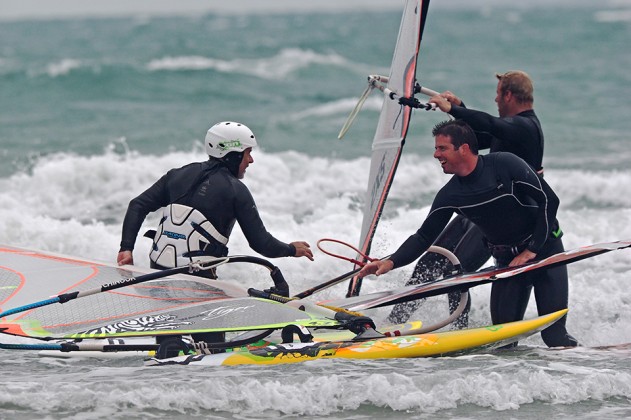THE MATE FACTOR
“You know a man by the company he keeps” said someone divine and famous. Harty peruses the pros and cons of windsurfing mates.
In search of a better education for their children, many parents are prepared to make astonishing sacrifices, doing without holidays and even the latest mobile phone to pay for private education. However, studies have revealed that while a ‘better’ school with smaller classes, less gun crime and more happiness seminars may help the cause, the factor that has the greatest influence on their child’s progress, or lack of it, is something they have little control over, and that is his or her peer group. If little Johnny is thrown together with a bunch of over-privileged, pill-popping wastrels who’ve signed up to the ‘it’s cool to be a fool’ ethic, then no matter how bright and motivated he starts out, he’ll soon sink to the level of the lowest common denominator. The opposite is equally true.
Dr Sugata Mitra is an Indian scientist and educationist famous for his ‘hole-in- wall’ experiment. In one of the worst slums in New Delhi, he fixed a touch screen computer into a wall with a high-speed internet connection and just stood back and observed. He was interested in the concept of ‘minimally invasive education,’ believing that children have an innate curiosity and ability to self teach, if only left to their own devices. And sure enough, within a few weeks, children from hideously deprived backgrounds with no formal education and zero computer knowledge had not only taught themselves to navigate the computer but were also completing complicated tasks like surfing the net, using the camera and editing little movies.
But what was equally revealing was the way they did it. They naturally formed into small groups of mixed ages. Big kids enjoyed teaching little kids who then enjoyed teaching littler kids. It’s not so much a showy-offy thing as an instinctive pleasure in sharing information and making collective progress. No one learned by themselves.
This month’s technique episode features wave sailing through the eyes of a group of south coast sailors, the majority of whom this winter have found another level thanks partly to an unrelenting run of wind and waves but also to a group dynamic which mirrors Dr Mitra’s experiment. There was no uber-guru involved (sadly) laying his hands on the afflicted. The alchemy seemed to come from the mix of abilities, a non toxic rivalry and above all from simple sharing of information AND the understanding that while everyone wants to improve, it’s supposed to be a laugh.
Another thread in this issue is the role of the internet on our sport. Waiting to depart from the Tobagan airport lounge last week, I put the question to my group (many of whom were just old enough to remember the pre-digital era) whether or not they saw it as an influence for good or bad. For every ‘pro’ statement, there was an equally persuasive ‘con.’
Instant reliable forecasts … yes but that means no one bothers going out in light winds.
So much information on how to do stuff … yes, but a lot of it is made up on the spot by someone who has found ‘a way’ but not necessarily a good way – and let’s not even mention the forum trolls…
So easy to record and share your watery experiences … yes, but we can get so wrapped up in the recording of the moment and making the movie that we forget to live in the moment and actually enjoy the experience.
However, this winter I did witness a wholly positive use of technology. It was WhatsApp. I’m sure you’re familiar. It’s an easy instant way of sharing messages and pics within a group. I was included in the aforementioned local sailors group. To begin with it was mildly annoying – just lots of ‘noise’ when you’re trying to get things done. But before during and after a session, it’s pure gold. There’s simple information like “don’t bother coming down it’s swung dead onshore and dropped” but more compelling is the motivational stuff.
Here’s a brief snippet following a February session.
“Congrats Jan on one handed backies.”
“And Jon for stalled forward.”
“Monkey bailed push loop was the highlight.”
“Please … please… did anyone see my forward?!!”
The posts are from pros and ams alike, said Emile Kott, one of the founder members: “It’s really inspirational because you want to be the one people are talking about.”
Many regard windsurfing as a solitary sport. In a good way, it is a means to lose yourself and get away from the hubbub and bussle. But in a bad way some spots are like being lonely in a city, where thousands of people live within millimetres of each other without ever relating. On those rare beaches everyone lives in their own space. No one is improving because no one is talking and sharing.
People ask me why they should come on a clinic rather than getting a few hours private tuition (for quite a bit less money). The commercial answer is that on a clinic you will be fed day and night the finest technical information from a youthful, coherent athlete. But the true answer is that, if the social mix is right, you will be inspired by the performances of your peers. Windsurfing brings out the best in (most) people and you will delight in their accomplishments as they will delight in yours. And perhaps the most rewarding moment of all will come not from you improving but when someone says they were motivated to do their first gybe because they’d seen you do it.
It’s an easy formula – on the water, surround yourself with fun, generous, motivated people who are trying stuff.
Peter Hart 25th March 2016, 03:24 AM.
PHOTO – The sharing of watery love and information. Photo PH Photography

